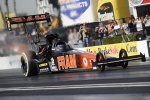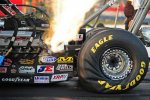
There?s not much we love more than the history of hot rods and drag racing. Front engine dragsters and early funny cars will always light our fire, but the specs of the modern day versions are just too insane to ignore. Here are 16 facts that will make any gearhead?s jaw drop.
? One Top Fuel 500 cubic-inch Hemi engine makes more horsepower (8,000 HP) than the first four rows of cars at the Daytona 500.
? Under full throttle, a dragster engine consumes 11.2 gallons of nitro methane per second; a fully-loaded 747 consumes jet fuel at the same rate with 25% less energy being produced.
? A stock Dodge Hemi V8 engine cannot produce enough power to merely drive the dragster?s supercharger.
? With 3000 CFM of air being rammed in by the supercharger on overdrive, the fuel mixture is compressed into a near-solid form before ignition. Cylinders run on the verge of hydraulic lock at full throttle.
? At the stoichiometric 1.7:1 air/fuel mixture for nitro methane the flame front temperature measures 7050 degrees F.
? Nitro methane burns yellow. The spectaclar white flame seen above the stacks at night is raw burning hydrogen, dissociated from atmospheric water vapor by the searing exhaust gases.
? Dual magnetos supply 44 amps to each spark plug. This is the output of an arc welder in each cylinder.
? Spark plug electrodes are totally consumed during a pass. After 1/2 way, the engine is dieseling from compression plus the glow of exhaust valves at 1400 degrees Fahrenheit. The engine can only be shut down by cutting the fuel flow.
? If spark momentarily fails early in the run, unburned nitro builds up in the affected cylinders and then explodes with sufficient force to blow cylinder heads off the block in pieces or split the block in half.
? Dragsters reach over 300 MPH before you have completed reading this sentence.
? In order to exceed 300 MPH in 4.5 seconds, dragsters must accelerate an average of over four Gs. In order to reach 200 MPH well before half-track, the launch acceleration approaches eight Gs.
? Top Fuel engines turn approximately 540 revolutions from light to light!
? Including the burnout, the engine must only survive 900 revolutions under load.
? The redline is actually quite high at 9500 RPM.
? Assuming all the equipment is paid off, the crew worked for free, and for once, NOTHING BLOWS UP, each run costs about ?1,000 per second.
? 0 to 100 MPH in .8 seconds (the first 60 feet of the run), 0 to 200 MPH in 2.2 seconds (the first 350 feet of the run), six g-forces at the starting line (nothing accelerates faster on land) , six negative g-forces upon deployment of twin ?chutes at 300 MPH. An NHRA Top Fuel Dragster accelerates quicker than any other land vehicle on earth, and quicker than a jet fighter plane ? even quicker than the space shuttle.

